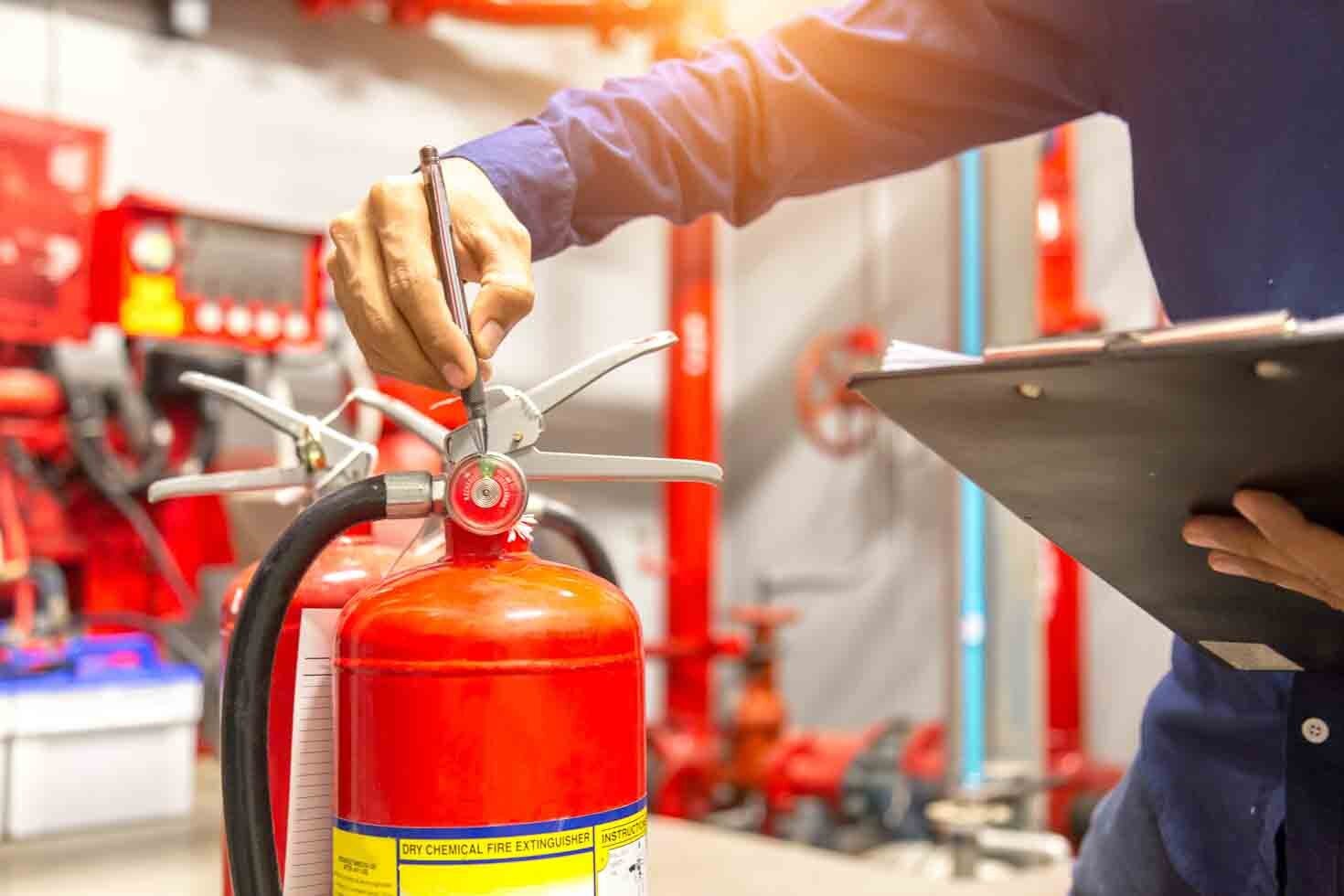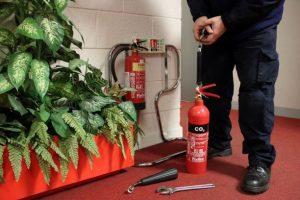![]()
Fire Immuniser
+91-7829629111
Email: info@variex.in
Varistor Technologies Pvt. Ltd.
Block-1, First Floor, Ardente Office One, Hoodi Circle, ITPL Main Road, Bengaluru, Karnataka 560048, IN
Refilling Fire Extinguishers: Is Your Safety Up for Renewal?
In a world where unexpected challenges often catch us off guard, safeguarding our homes, workplaces, and public spaces has become an imperative task. One of the fundamental components in the arsenal of safety measures is the trusty fire extinguisher, a silent sentinel standing ready to combat the unpredictable threat of flames. As time progresses and safety standards evolve, the question that looms large is whether our firefighting preparedness is keeping pace. This leads us to a critical inquiry: "Refilling Fire Extinguishers: Is Your Safety Up for Renewal?"
The importance of fire extinguishers in averting disaster cannot be overstated. These devices, strategically placed in various locations, serve as the first line of defense against the destructive force of fires, offering a swift and decisive response in those crucial initial moments. However, much like any other safety equipment, fire extinguishers demand regular attention and maintenance to ensure their efficacy. The title phrase encapsulates the essence of this imperative - the notion that the act of refilling fire extinguishers is not merely a routine chore but a renewal of our commitment to safety.
As we delve deeper into the intricacies of fire extinguisher maintenance, it becomes evident that their efficiency is contingent upon more than just their physical presence. The process of refilling, a seemingly mundane task, is, in fact, a meticulous operation that ensures each extinguisher is charged and primed for action. This begs the question: How often do we consider the status of our fire extinguishers and the currency of our safety? This exploration goes beyond the technical aspects of refilling fire extinguishers; it delves into the broader narrative of our collective responsibility towards safety. The renewal of fire extinguishers is emblematic of a broader commitment to proactive safety measures—a commitment that reflects an understanding of the evolving nature of potential threats. It prompts us to reassess the adequacy of our safety protocols, encouraging a culture of preparedness that goes beyond the superficial and reaches into the core of our shared responsibility for one another's well-being.
Importance of Fire Extinguisher Maintenance
These devices stand as stalwart guardians, ready to mitigate the potentially devastating impact of fires when deployed promptly and effectively. However, their reliability hinges on a factor often overlooked—regular maintenance, with a key aspect being the vital process of refilling fire extinguishers.
1. Early Detection and Swift Response: Fire emergencies are often characterized by their sudden and unpredictable nature. In such critical moments, the difference between containment and catastrophe lies in the speed of response. Maintaining fire extinguishers in optimal condition ensures that they are ready for immediate use. Regular inspections, including refilling, are crucial for keeping them primed and prepared to act swiftly when needed.
2. Prolonging Operational Life: Much like any mechanical device, fire extinguishers have a finite operational life. Routine maintenance, encompassing inspections, testing, and refilling, contributes significantly to extending their lifespan. Neglecting these aspects may result in reduced effectiveness or, worse, failure during a fire emergency. By prioritizing maintenance, individuals and organizations can ensure that their fire extinguishers remain reliable over the long term.
3. Compliance with Safety Regulations: Adhering to safety regulations and standards is not only a legal obligation but a moral responsibility. Regular fire extinguisher maintenance, including the essential refilling process, aligns with safety codes and regulations. This compliance not only safeguards against legal repercussions but, more importantly, reinforces a commitment to creating secure environments for occupants and assets.
4. Addressing Changing Environmental Conditions: Environmental factors such as temperature, humidity, and exposure to various elements can impact the performance of fire extinguishers. Routine maintenance, which encompasses refilling to replenish extinguishing agents, addresses these environmental challenges. This proactive approach ensures that the devices remain effective under diverse conditions, providing a robust defense against potential fire hazards.
5. Comprehensive Inspection for Hidden Issues: Routine maintenance is not just about refilling the extinguishing agent; it involves a comprehensive inspection to identify any hidden issues. This can include checking for leaks, assessing pressure levels, and examining the overall integrity of the extinguisher. Addressing these issues promptly through refilling or necessary repairs prevents potential malfunctions and ensures the device's reliability.
When Your Fire Extinguisher Signals It Needs Refilling
Fire extinguishers play a vital role in ensuring our safety, standing as the unsung heroes that can swiftly tackle the unexpected menace of fires. Yet, like any piece of equipment, they require regular care and attention to maintain their effectiveness. Understanding the signs that indicate your fire extinguisher might need help, particularly in the form of refilling fire extinguishers, is crucial for ensuring its readiness when emergencies strike.
1. Weight Loss - Gauge the Vigor: Consider your fire extinguisher as a weight-limited warrior. If, during routine checks, you notice a significant decrease in its weight, it could be signaling a loss of its extinguishing agent. Much like an athlete needing the right fuel, a fire extinguisher requires its proper "weight" to be fully equipped for potential fire encounters. Refilling fire extinguishers in this scenario becomes akin to replenishing the essential nutrients, ensuring that the extinguisher is primed and prepared for the demands of the firefighting arena.
2. Pressure Check - Gauge the Vigilance: The pressure gauge on your fire extinguisher serves as a reliable health indicator. Think of it as a vital sign monitor for your safety sentinel. A noticeable drop in pressure levels may suggest that your extinguisher is experiencing a decline in its internal vigor. Regularly monitoring and addressing these pressure variations through refilling fire extinguishers ensures they maintain their optimal operational pressure, ready to respond with full force at a moment's notice.
3. Physical Health Check - Bumps and Bruises Matter: Much like a warrior's armor, the outer shell of a fire extinguisher matters. Dents, rust, or other visible damages could compromise its structural integrity. A proactive approach involves more than just refilling the extinguishing agent; it's an opportunity to conduct a thorough physical health check, addressing any bumps and bruises that might hinder its performance during a critical firefighting mission.
4. Outdated Inspection Tag - The Timekeeper's Reminder: Every fire extinguisher bears a timestamp in the form of an inspection tag. A neglected or outdated tag is akin to a ticking clock, signaling that the extinguisher might be overdue for attention. Regular refilling fire extinguishers, as part of routine inspections, is the timely intervention needed to reset the clock, ensuring that your safety equipment is in sync with the demands of contemporary safety standards.
5. Unusual Noises - Listening to Distress Signals: Your fire extinguisher communicates through more than just visual cues. Unsettling sounds, such as hissing or gurgling, can be distress signals. These auditory hints might point to internal issues, possibly leaks or other complications. Just as you would investigate unsettling noises in your home, addressing these audible signals through refilling fire extinguishers becomes an essential step in maintaining the extinguisher's overall health and reliability.
The Refilling Process: A Necessity Unveiled
Refilling fire extinguishers is not just a routine maintenance task; it's a crucial aspect of ensuring their operational readiness. The process involves replenishing the extinguishing agent, whether it be water, foam, dry chemical, or another specialized substance. This replenishment is essential to maintain the extinguisher's effectiveness in combating various types of fires.
A Simple Guide to Giving Your Extinguisher a Boost
Understanding the refilling process doesn't have to be complicated. Here's a simple guide to help you navigate through the steps:
Assessment of the Extinguisher: Begin by visually inspecting your extinguisher for any signs of damage, such as dents, rust, or leaks. This step ensures that the extinguisher is in good physical condition before proceeding with the refilling process.
Selection of the Right Extinguishing Agent: Identify the type of extinguishing agent required for your specific extinguisher. Using the wrong agent can compromise the effectiveness of the device, so it's crucial to choose the appropriate substance.
Professional Assistance or DIY?: While some may attempt to refill their extinguishers independently, it's often advisable to seek professional assistance. Certified technicians possess the expertise to perform the task accurately and guarantee that the extinguisher is in compliance with safety standards.
Pressure Check: Ensuring that the extinguisher is pressurized correctly is vital. This step involves verifying that the pressure gauge indicates the recommended levels, assuring that the device is ready for immediate use.
Sealing and Tagging: Once the refilling process is complete, the extinguisher is sealed to prevent tampering. A new inspection tag is affixed, indicating the date of the refill and providing a record for future inspections.
Common Mistakes to Avoid
Understanding the nuances of the refilling process also involves recognizing potential pitfalls. Here are common mistakes to steer clear of:
Ignoring Regular Inspections: Neglecting routine inspections can lead to overlooking signs of damage or pressure loss. Regular checks are crucial for early detection and timely refilling.
Using the Wrong Extinguishing Agent: Each extinguisher is designed for specific fire types. Using the wrong extinguishing agent can compromise its effectiveness. Always ensure you are refilling with the correct substance.
DIY Complications: Attempting to refill an extinguisher without the necessary expertise can result in errors, potentially rendering the device ineffective or even dangerous. Professional assistance is recommended.
Incomplete Sealing and Tagging: Failing to properly seal and tag the extinguisher post-refill can lead to unauthorized tampering and may impact compliance with safety regulations.
Timing is Key for Safety: The Refilling Fire Extinguisher Process
Fire safety is a dynamic responsibility, and ensuring that your fire extinguisher is always ready for action involves more than just passive ownership. Timing becomes a crucial element in this safety equation, emphasizing the need for a well-structured schedule to navigate the refilling fire extinguisher process. In this blog post, we'll explore why timing is key, guide you in creating a schedule for taking care of your extinguisher, and shed light on when your extinguisher might need an instant pick-me-up.
Why Timing Matters in Refilling Fire Extinguishers
Preventing Operational Gaps: Regularly scheduled refilling ensures that your fire extinguisher is continuously operational. Gaps in its readiness could prove disastrous in the event of a fire emergency, underscoring the importance of a timely refill to maintain a consistent state of preparedness.
Adhering to Safety Standards: Safety regulations often mandate specific intervals for inspecting and refilling fire extinguishers. Adhering to these standards is not only a legal obligation but a proactive step in guaranteeing that your safety equipment complies with the latest safety protocols.
Addressing Wear and Tear: Like any tool, fire extinguishers undergo wear and tear. A well-timed refill provides an opportunity to not only replenish the extinguishing agent but also to address any physical damage, ensuring the extinguisher remains structurally sound and effective.
Creating a Schedule for Taking Care of Your Extinguisher
Routine Inspections: Implement a monthly visual inspection routine. Look for any visible signs of damage, leaks, or changes in pressure. This proactive measure serves as an initial checkpoint, allowing you to catch potential issues before they escalate.
Scheduled Professional Inspections: Enlist the services of certified professionals for a comprehensive inspection at least once a year. These experts have the knowledge and tools to conduct thorough assessments, including the critical task of refilling fire extinguishers according to safety standards.
Bi-annual Maintenance Checks: Every six months, perform a more detailed inspection, checking for pressure levels, the condition of seals, and ensuring that all components are in working order. This mid-year assessment helps maintain the extinguisher's reliability.
When Your Extinguisher Needs an Instant Pick-Me-Up
Sudden Pressure Drop: If your monthly inspection reveals a sudden drop in pressure, don't hesitate to schedule an immediate refill. A timely response to pressure irregularities ensures that your extinguisher is consistently ready for use.
Visual Damage or Leaks: Any visible signs of damage, including dents, rust, or leaks, should prompt an instant pick-me-up. Addressing physical issues promptly, alongside refilling fire extinguishers, ensures the extinguisher's overall health.
Outdated Inspection Tags: If the inspection tag indicates that your extinguisher is due for a refill, prioritize this task. An outdated tag serves as a clear signal that it's time to bring your extinguisher back to its peak operational condition.
In conclusion, the journey through the intricacies of fire safety and the imperative nature of maintaining fire extinguishers has brought us to a crucial realization: our safety is indeed up for renewal, and the linchpin of this renewal lies in the conscientious act of refilling fire extinguishers. As we've navigated the various facets of fire extinguisher maintenance, it becomes abundantly clear that these devices, often overlooked in their silent vigilance, demand our attention and commitment to ensure they stand ever-ready for the unpredictable challenges fire may present. The process of refilling fire extinguishers emerges not as a mere chore but as a pledge—a commitment to the safety of our homes, workplaces, and public spaces.
Consider the parallels between renewing a subscription or updating software. In the realm of fire safety, the periodic act of refilling fire extinguishers serves as the software update, fortifying our first line of defense against the unexpected. It's the renewal of our collective promise to be vigilant custodians of our safety, acknowledging that the effectiveness of our firefighting equipment directly impacts our ability to safeguard lives and property. This exploration has underscored the importance of a proactive approach, urging us to transcend complacency and engage in regular assessments of our safety measures. Safety, after all, is not a stagnant concept but a dynamic process that demands our continuous involvement and adaptation to evolving standards. The phrase "Is Your Safety Up for Renewal?" becomes not just a question but a rallying call—an invitation to reflect on our commitment to safety and take affirmative action. As we incorporate the lessons learned about the critical role of refilling fire extinguishers, let it resonate as a metaphor for the broader ethos of safety in our lives. Just as we renew subscriptions to keep our digital lives secure, so too must we renew our commitment to fire safety through regular maintenance, inspections, and the timely act of refilling fire extinguishers.
Frequently Asked Questions
1.Why is refilling fire extinguishers important?
Refilling fire extinguishers is crucial to ensure they are ready for action in case of a fire. Over time, the extinguishing agent may deplete, and refilling helps maintain their effectiveness, keeping you prepared for emergencies.
2. How often should I refill my fire extinguisher?
The frequency of refilling depends on the type of extinguisher and local regulations. Generally, it's recommended to have a professional inspection at least once a year, and refilling should occur whenever the extinguisher is used or if there are signs of damage.
3. Can I refill a fire extinguisher myself?
While some extinguishers allow for DIY refilling, it's safer and more effective to seek professional help. Certified technicians have the expertise to ensure the correct extinguishing agent is used and that the device complies with safety standards.
4. How do I know if my extinguisher needs refilling?
Regular inspections are key. Look for weight loss, pressure drop, visual damage, or outdated inspection tags. If you notice any of these signs during routine checks, it's time to consider refilling.
5. What happens if I don't refill my fire extinguisher?
Failing to refill your fire extinguisher can result in its ineffectiveness during a fire emergency. The extinguishing agent may be depleted, and the device might not function properly. Regular refilling is crucial to ensure its reliability.
Final Say
We at VariEx.in or Variexonline.com have mastered the art of designing, installing, inspecting, and fixing automatic sprinkler systems with the help of our in-house team, which is capable of delivering the fire sprinkler services you need, whether large or small and at affordable cost.
To schedule a fire sprinkler installation, or you think our services could benefit your commercial property, contact us online or give us a call at, 7829629111









